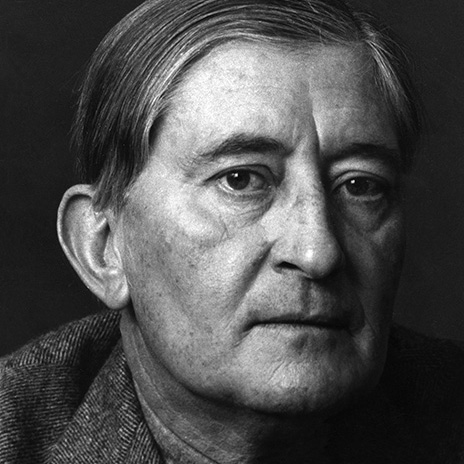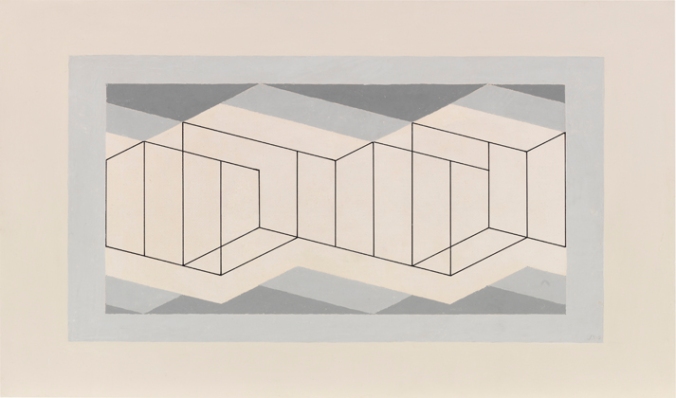
Source: Josef and Anni Albers Foundation
Background
Born on March 19, 1888 in the town of Bottrop in Westphalia, Germany, Josef Albers is an artist who made significant contributions to the modern art education programs of the 20th century. Though he began work as a schoolteacher in his home town, art truly became his passion. In 1916 Albers started in printmaking at the Kunstgewerbschule in Essen, and in 1918 he received his first public commission for a stained-glass window for a church in the area.
With his skills as a maker of stained glass, he joined the faculty of the Bauhaus in 1922. Doing well in his roll, he was eventually promoted to professor in 1925, the same year he would marry his wife, Anni Albers (née Fleischmann). At the same time he was at the Bauhaus, other notable artists included Oskar Schlemmer, Wassily Kandinsky, and Paul Klee. Unfortunately, with the rise of the Nazi’s in Germany the Bauhaus was closed in 1933. Following this Albers and his wife emigrated to the United States where he would take a job as the head of a new painting program in Black Mountain College in North Carolina. He would stay there until 1950 when he left to head the department of design at Yale University. Albers would retire from teaching in 1958. In 1963, he would publish one of his most well known works called Interaction of Color which presented a theory of color being based on an internal and deceptive logic.
Every perception of colour is an illusion…we do not see colors as they really are. In our perception they alter one another. — Albers in 1949
His contributions to art would see him elected to the American Academy of Arts and Sciences in 1973, and he would remain active until his death in 1976.
Art

Source: Homage to the Square, 1949+
Though he had great skill as a designer, photographer, typographer, printmaker, and as a poet, it is primarily his work as an abstract painter and theorist for which he is remembered. Albers most famous works are the hundreds of paintings and prints he created to make up the series Homage to the Square. In this series, he explored chromatic color interactions with nested squares. His technique called for him to paint on Masonite, using a palette knife with oil colors.
Albers is particularly known for meticulously recording information on the specific manufacturer’s colors and vanishes he used in his work. In fact, he would often leave notes on the back of the works denoting which colors he used. The colors of his abstract works would go on to influence hard-edge abstract painters, while his interest in perception would spur on conceptual artists.

Source: Light Construction, 1945
Where to See His Work
- Josef and Anni Albers Foundation
- Museum of Modern Art, New York
- Solomon R Guggenheim Museum, New York
- Tate Museum, London
For More Information
Josef and Anni Albers Foundation: Founded in 1971 and located in Bethany, Connecticut, it is a nonprofit organization that aims to further the “revelation and evocation of vision through art.” To this day it serves as an office to the estates of both Josef Albers and his wife Anni Albers, and continues to support exhibitions and publications focused on their works.
Books
- Interaction of Color: 50th Anniversary Edition: Conceived as a handbook and teaching aid for artists, instructors, and students, this influential book presents Albers’s singular explanation of complex color theory principles. this new edition presents a significantly expanded selection of close to sixty color studies alongside Albers’s original text, demonstrating such principles as color relativity, intensity, and temperature; vibrating and vanishing boundaries; and the illusion of transparency and reversed grounds. A celebration of the longevity and unique authority of Albers’s contribution, this landmark edition will find new audiences in studios and classrooms around the world.
- Josef Albers: To Open Eyes: This book reveals Albers’ formative philosophies on art, life and the nature of perception through first-hand accounts of more than 150 students and colleagues over more than 40 years.
- Josef Albers: Life and Work: Drawing on extensive unpublished archival writings, documents, and illustrations, this is the first full-scale biography of one of the 20th-century’s great artists. In his accessible study of the “whole” Albers, Charles Darwent combats the fables while telling the fascinating story of an artist, friend, and intellectual. Among Albers’s unpublished papers are letters from friends John Cage, Robert Rauschenberg, Richard Serra, and Eva Hesse, as well as fans and collectors ranging from the composer Virgil Thomson to the cartoonist Saul Steinberg. If his network of influence was surprisingly wide, so too, were his interests. He started life at the Bauhaus as a glass-maker and went on to create fonts, to run their famous wallpaper workshop, and to make furniture whose designs are still in production eighty years later. He pioneered the study of color at Black Mountain College in North Carolina and chaired the design department at Yale University. While books have been written about Albers for specialist audiences, this new volume fulfills the clear need for a more general study.
This article contains some affiliate links to books that I recommend as references to the art and life of the German-American Artist Josef Albers. If you choose to purchase these books via my affiliate links, you will help support my writing and research at no additional cost to you.